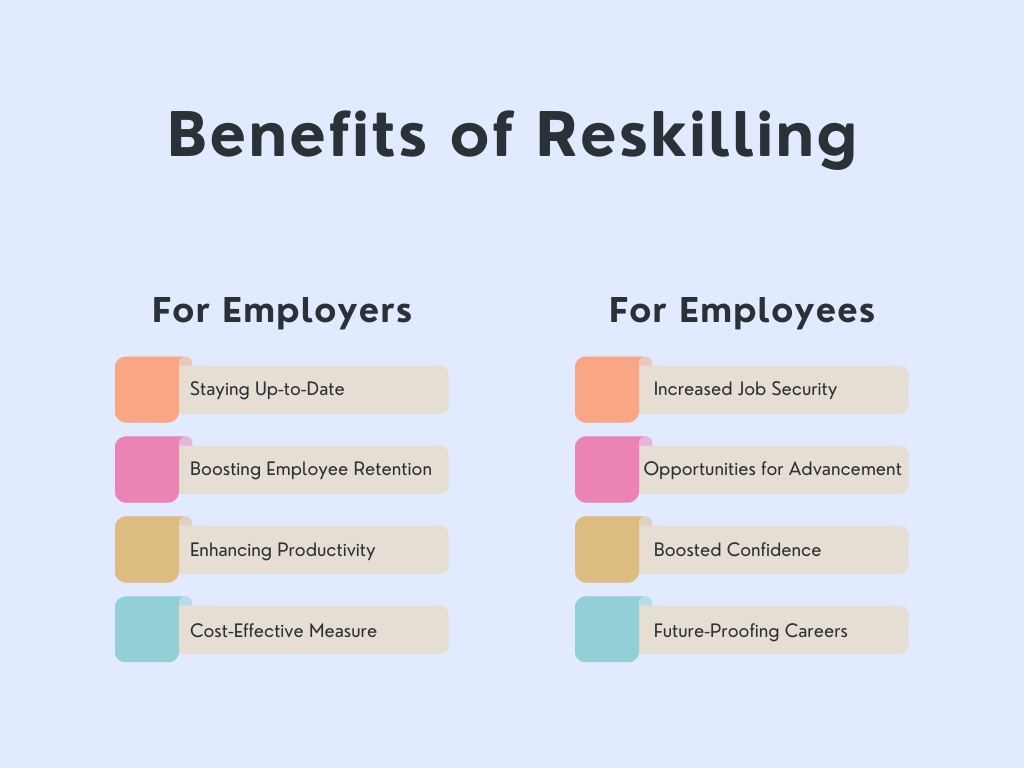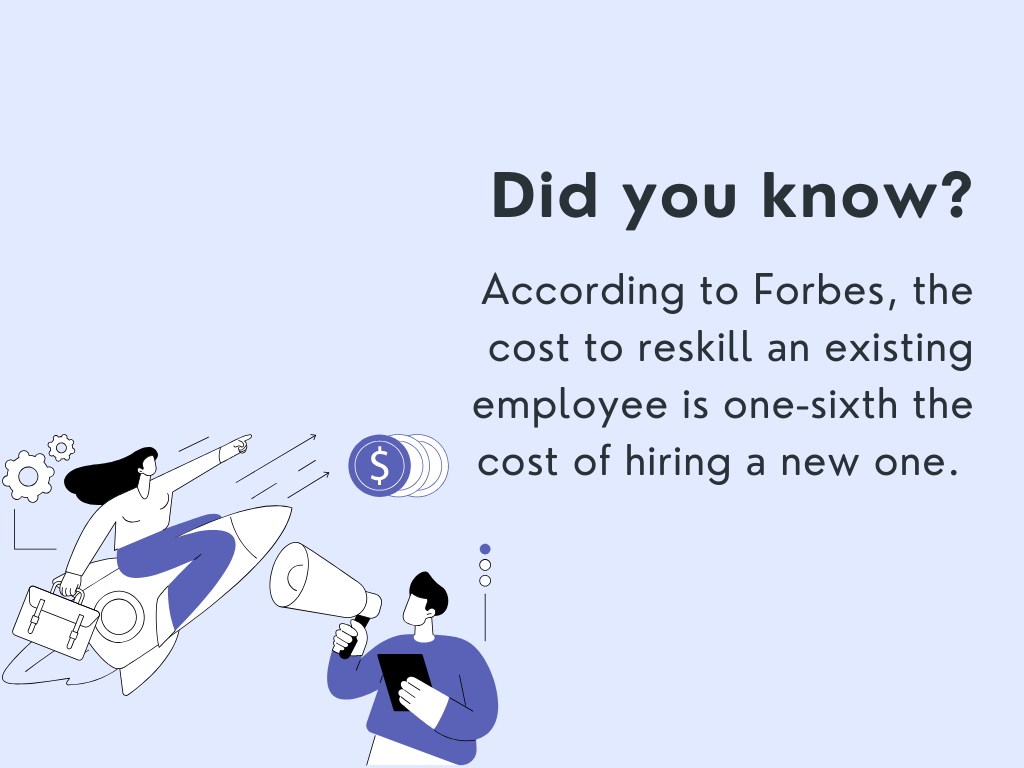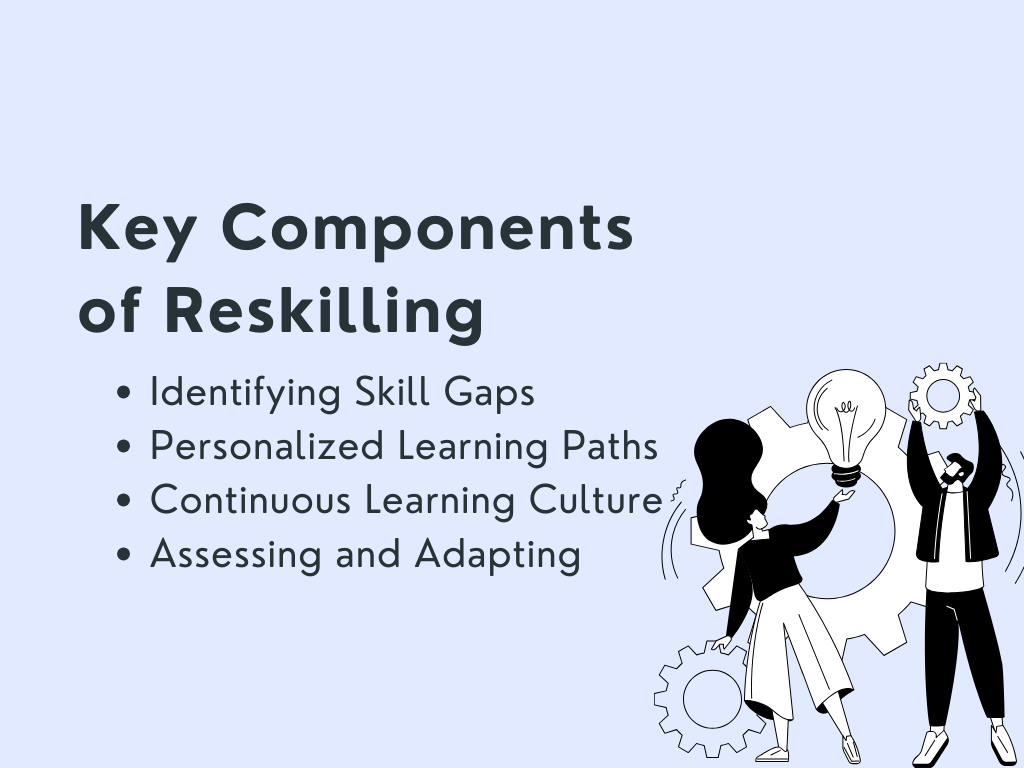Table of Contents:
- What Is Reskilling? Definition and Overview
- The Benefits of Reskilling
- How to Introduce Reskilling to Your Company Culture
- Tips for Successful Reskilling Programs
- Reskilling Case Studies and Examples From Big Companies
Introduction
As companies navigate this period of technological and economic change, reskilling your workforce is critical for maintaining a competitive advantage.
For companies seeking to future-proof their business, reskilling provides a solution.
By teaching your employees new, in-demand skills, you ensure they stay relevant and that your company is poised to adapt to industry shifts.
For employees, reskilling offers a chance to learn skills that will keep them employed.
What Is Reskilling? Definition and Overview
Reskilling refers to training your existing workforce to gain new skills that match the evolving needs of your business.
It's about equipping your employees with the tools and skills they need to adapt to new business demands, evolving technologies, and shifting job roles.
As technology and markets change rapidly, many of the skills that employees currently have may become outdated. Reskilling helps ensure your workforce remains relevant and competitive.

The Benefits of Reskilling
Reskilling your workforce provides numerous benefits to companies, for both employers and employees.

Numerous Benefits for Employers
There are countless reasons why reskilling is a sound investment for employers, including:
- Staying Up to Date: The advent of new technologies requires the workforce to possess a new set of skills. By investing in reskilling, employers ensure their workforce is always current and equipped to handle challenges.
- Boosting Employee Retention: Learning opportunities increase employee engagement and job satisfaction, which in turn, improves retention rates. According to LinkedIn's 2018 Workforce Learning Report, a whopping 94% of employees would stay at a company longer if it invested in their career development.
- Enhancing Productivity: Training current employees to enhance their skills can boost their productivity levels. According to a report by the National Center on the Educational Quality of the Workforce (EQW), increasing education by 10% leads to an 8.6% increase in productivity.
- Cost-Effective Measure: Training existing employees can be much more cost-efficient than hiring new ones. A 2020 report by the Society for Human Resource Management states that the average cost per hire is $4,129, while the average cost of reskilling an employee is considerably lower.
Significant Gains for Employees
For employees, reskilling opens up new opportunities and long-term benefits:
- Increased Job Security: In this ever-changing job market, possessing relevant skills increases job security. Reskilling helps employees stay relevant in their chosen fields.
- Opportunities for Advancement: Reskilling equips employees with the tools they need to advance in their current roles or transition into new ones. It allows them to pave their career pathways and achieve their aspirations.
- Boosted Confidence: Learning new skills can help employees feel more competent and confident in their roles, thereby increasing their job satisfaction and motivation levels.
- Future-Proofing Careers: By continuously updating their skills, employees can future-proof their careers. According to the World Economic Forum Future of Jobs Report, more than half (54%) of all employees will require significant reskilling by 2022.
By teaching existing employees new skills that match current business needs, you can fill gaps, increase productivity, and boost employee satisfaction.
Reskilling also allows you to retain institutional knowledge that would otherwise be lost.
Reskilling leads to a more engaged and motivated workforce. Employees appreciate opportunities to learn and advance their careers.
Providing reskilling programs shows your employees you value them and are invested in their success.

How to Introduce Reskilling to Your Company Culture
To successfully introduce reskilling to your company culture, follow these steps:
Communicate the vision
Explain to employees the vision and rationale behind reskilling. Share the benefits, such as improving job security, increasing career opportunities, and staying competitive.
Frame it as an investment in them and their futures. Be transparent about how reskilling will impact roles and responsibilities.
Identify skills gaps
Conduct an analysis to determine which jobs are most at risk and the skills most needed.
Assess employee skills, strengths, and interests to match training programs to individuals. Some methods for analysis include:
- Skills audits: Have employees self-report their skills and experience.
- Performance reviews: Identify top and bottom performers to determine skills gaps.
- Departmental focus groups: Bring together teams to discuss challenges and the skills needed to meet key objectives.
Develop training programs
Partner with learning providers to develop customized programs. Consider mentoring, job shadowing, online courses, and on-the-job training.
Keep programs flexible, accessible, and tailored to different learning styles. Offer incentives like bonuses or extra paid time off for completing training.
Lead by example
Managers and executives should participate in reskilling themselves to set an example.
Share stories of career progression through reskilling. Recognize and reward employees who complete training programs.
Promote from within whenever possible to demonstrate career growth opportunities.
Reskilling your workforce is a long-term strategy that requires ongoing investment and commitment.
By making reskilling a part of your company culture, you ensure your organization’s competitiveness and your employees’ job security and career success.
With the rapid pace of change, reskilling is the key to a future-ready workforce.
Tips for Successful Reskilling Programs
To successfully reskill your workforce, focus on the following tips:
Conduct a Comprehensive Skills Gap Analysis
The reskilling journey begins with an understanding of where you are and where you want to go.
Organizational leaders must identify current talent capabilities and compare them with the skills needed for the future.
Through a robust skills gap analysis, you can understand your organization's strengths and weaknesses and develop a reskilling strategy that addresses these gaps effectively.
Align Reskilling with Business Goals
Reskilling initiatives should not operate in a vacuum. They must align with the larger business strategy.
For any reskilling program to be successful, its objectives must be tied back to business goals like productivity, innovation, customer satisfaction, and competitive advantage to foster a cohesive, unified growth plan.
Provide Adequate Training
It is essential to provide comprehensive training for employees learning new skills.
Make sure to allow enough time for them to become proficient. Consider offering opportunities for live or video-based instruction from subject matter experts, hands-on practice, simulations, and real-world application.
Supplement technical skills training with soft skills like communication, critical thinking, and adaptability.
Offer Incentives and Recognition
Offering incentives and recognition helps motivate employees to actively participate in reskilling programs.
Provide rewards like bonuses, extra time off, or public recognition to employees who achieve certification or mastery of new skills.
These types of incentives make employees feel valued and encourage ongoing learning and development.
Promote a Growth Mindset Culture
Foster a company culture that promotes a growth mindset. Help employees understand that skills and abilities can be developed over time with effort and persistence.
Provide opportunities for employees to strengthen a growth mindset through professional development resources on topics like neuroplasticity, grit, and learning from failure.
Leaders should also model a growth mindset in their own work and development.
Create Unique Learning Paths for Employees
Everyone learns differently and at their own pace. Thus, a one-size-fits-all approach to reskilling might not be effective.
Personalized learning paths, taking into account individual employee's interests, career goals, and learning styles, can cultivate a more engaged learning experience and drive better results.
Leverage a Variety of Modern Learning Tools
In an increasingly digital world, plenty of learning resources are readily available.
Harnessing the power of e-learning platforms, webinars, podcasts, MOOCs (Massive Open Online Courses), mentoring, and even social media platforms can provide diverse, interactive, and interesting ways to learn new skills.
Measure and Track Success
It is important to measure the success of your reskilling programs to determine what is working and make improvements.
Track key metrics like program completion rates, certification pass rates, employee satisfaction, productivity, and retention.
Survey employees before and after completing reskilling programs to gain valuable feedback on their experience.
Make data-driven decisions to enhance your reskilling initiatives over time.
Offer Cross-Training and Job Rotation
Cross-training, job rotation, and internal mobility programs are excellent ways to reskill your workforce.
Providing opportunities for employees to learn different roles, take on new responsibilities, and advance their careers internally makes them more versatile, engaged, and committed to your organization.
These programs also build a more flexible, future-ready workforce.
Regularly Evaluate and Review Outcomes
Continually assess your reskilling program performance. Use metrics like course completion rates, feedback surveys, and improvements in work performance, among others, to determine if your reskilling initiatives are effective.
Feedback loops can provide invaluable insights to refine and adapt the program as needed.

Reskilling Case Studies and Examples From Big Companies
To ensure your workforce has the skills required for future business needs, studying successful reskilling programs at leading companies can provide valuable insights.
AT&T
AT&T launched a $1 billion reskilling program to retrain nearly half of their workforce.
They offer online courses and mentoring in areas like software engineering, data science, and IT. Employees can earn certifications and degrees.
This program aims to reskill 100,000 employees by 2020. According to AT&T’s CEO, “There is a reskilling revolution underway in the world of work.”
Amazon
They are creating their own courses and partnering with community colleges to develop curricula and offer classes on-site.
Amazon hopes this investment in human capital will benefit both employees and the company.
The tech giant will pay full compensation and benefits during the leave. Google cited the speed of digital transformation and a tight labor market as reasons for this new policy.
They aim to retain top talent by providing opportunities for employees to build new, in-demand skills.
Other leading companies like JPMorgan Chase, Walmart, and Verizon have also committed billions of dollars to ambitious reskilling programs.
The future of work is rapidly evolving, and corporate investment in human capital has become crucial for business success and employee retention.
By studying successful examples, companies can craft impactful reskilling programs to future-proof their organizations.
Looking for a smart, efficient way to manage your reskilling workflow? Unlock the power of Sanka!
Conclusion
As the pace of change accelerates, reskilling your workforce is critical to stay competitive.
By investing in your employees' growth and development, you'll reap the rewards of a motivated, future-ready team.
Reskilling benefits both the company and the employee. For the company, reskilling leads to increased productivity, employee retention, and a workforce equipped with in-demand skills.
For employees, reskilling provides career opportunities, growth, and job security.
The steps to implement a successful reskilling program may seem daunting, but with proper planning and execution, reskilling can transform your company.
Begin by evaluating skills gaps, setting a vision, and communicating with employees.
Then, provide learning opportunities, mentorship, and incentives to keep your team engaged.
Reskilling is challenging work, but for forward-thinking companies, it is work that must be done.
The future is unwritten, but with a reskilled workforce, your company can write its own story of success.








